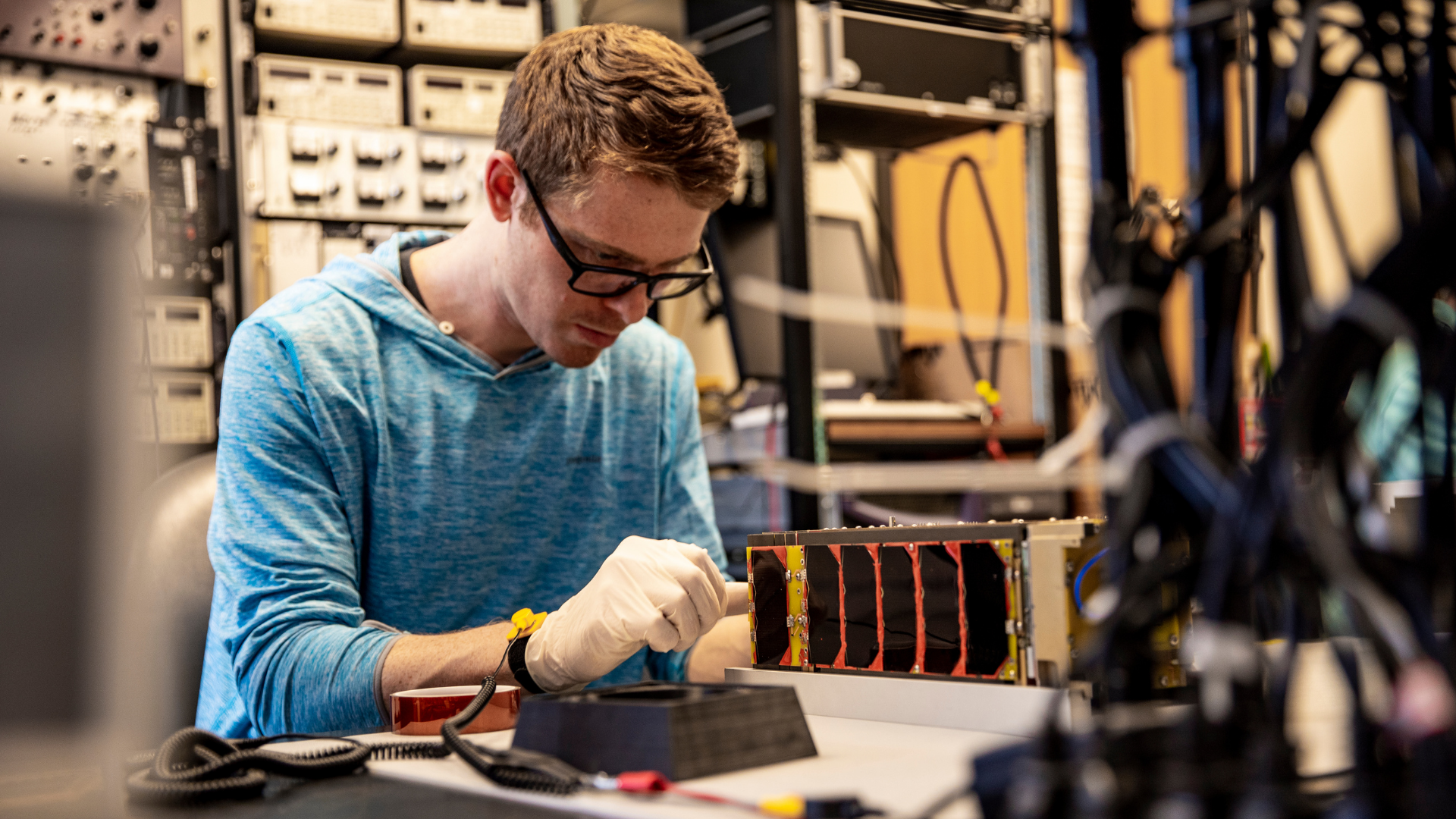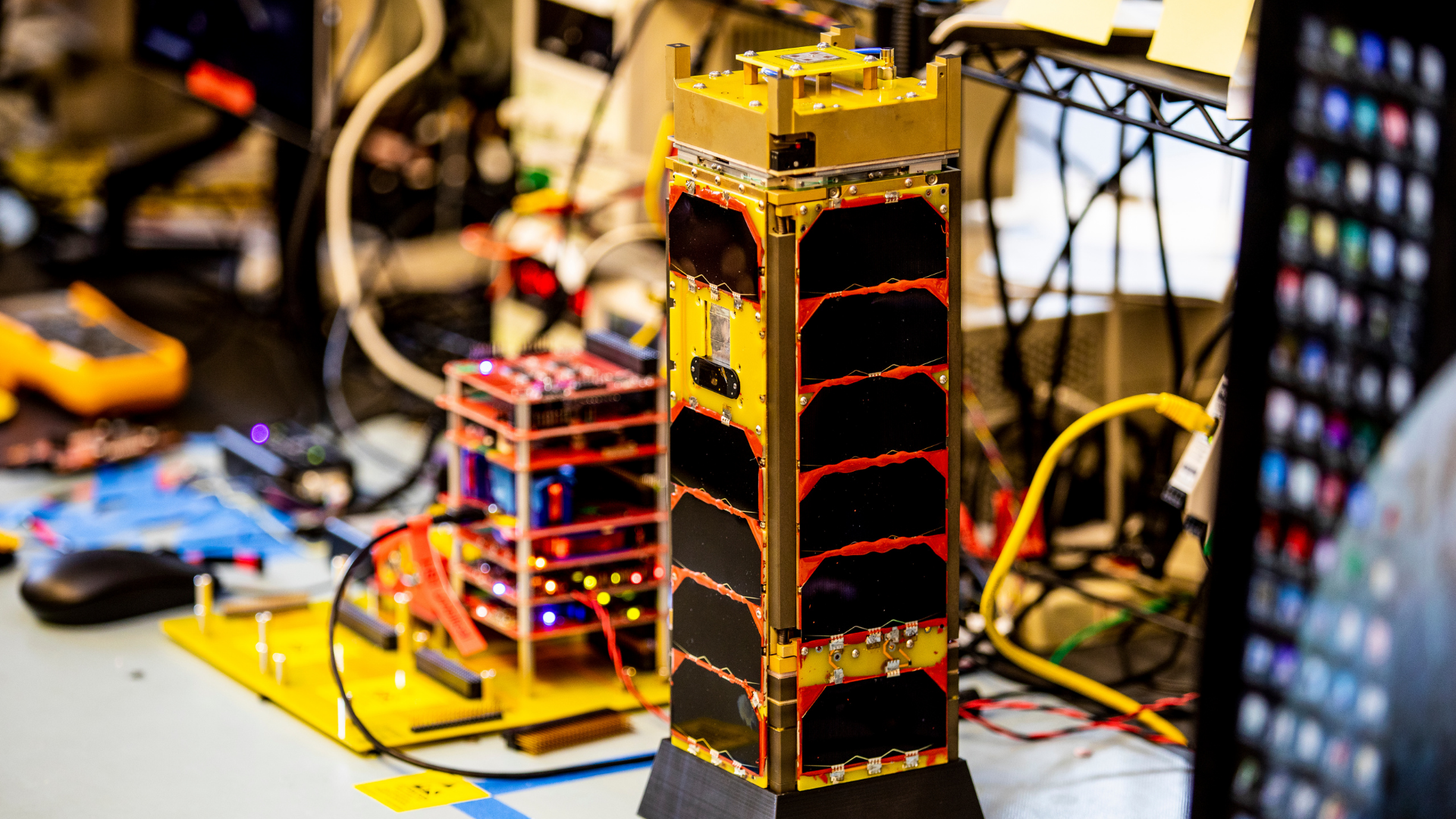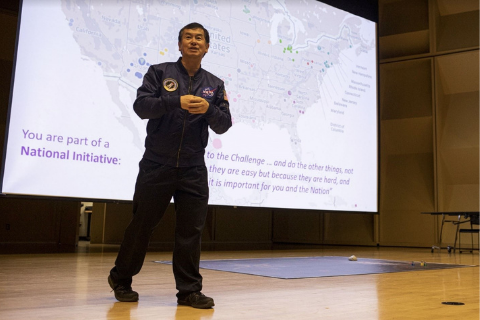WA Space Grant moves to A&A
WA Space Grant’s relocation to A&A will help strengthen hands-on student programs.
By: Amy Sprague
Top image caption: High altitude view of the Earth at night
A&A welcomes WA Space Grant, the renowned NASA program supporting undergraduates and graduate students in Washington state, to the department. Its mission is to increase access to and participation in STEM for underrepresented communities.
Mary Denmon, one of the Deputy Directors of WA Space Grant, details the many assets of the programs they manage, “We support so many opportunities for undergraduates including programs around rocketry, high-altitude ballooning, lava tube exploration, as well as the Husky Satellite Lab. And we fund close to 100 undergraduate summer research positions and scholarships from across majors at the UW as well as internships at NASA and fellowships for graduate students.”
A&A Chair Kristi Morgansen who is taking over as Principal Investigator of the program says, “WA Space Grant enhances our extracurricular and research offerings here in A&A. And we are especially interested in the expanded pathways into STEM. Aerospace, in particular, is currently one of the least diverse of the engineering disciplines. We are extremely happy to join forces.”
Sadly, this transition comes after the sudden passing of Director Robert Winglee, a professor and former chair in Earth & Space Sciences and a champion of getting students of all ages excited about space and science. Morgansen says, “We were terribly saddened by Robert’s passing. We will do our best to carry on his enthusiastic stewardship of this very influential program.”
She continues, “We are also looking forward to deepening A&A’s collaborations across other units at the UW through this program, particularly Astrobiology, Astronomy, Atmospheric Sciences, Physics, and the other engineering departments. The aerospace field was built across disciplines and its benefits reach across disciplines, so these meaningful opportunities to collaborate are crucial.”
This new partnership will strengthen many hands-on programs for students across the University, including the Husky Satellite Lab and Artemis Student Challenges.
Husky Satellite Lab bolsters A&A’s high altitude assets
CubeSats
One of WA Space Grant’s most recognized supported programs at the UW is the Husky Satellite Lab, which specializes in CubeSats and high altitude ballooning to test space capabilities. The Lab famously built HuskySat-1, Washington state’s first student-built CubeSat that launched into space in November 2019 in NASA’s Cygnus cargo spacecraft from the Wallops Flight Facility in Virginia. Lab members are currently developing HuskySat-2.
Husky Satellite Lab is moving to A&A to create a UW CubeSat cluster and share research and workshop space with the A&A CubeSat Team, which has itself secured a coveted ride on a NASA mission in late 2021 or 2022 of its Soc-I CubeSat.
Related story

SPACE SYSTEMS
Washington’s first student-built satellite preparing for launch
Husky Satellite Lab, which launched its first CubeSat in 2019, joins forces with the newer A&A CubeSat team.



Left: Paul Sturmer, a former UW master's student in physics making final adjustments as the system is fitted into the flight box. Top Right: An earlier model of the satellite, shown here in the lab, had solar panels on wings that unfold. The final model has solar panels attached on three sides to provide electrical power. Bottom right: The completed satellite in the Husky Satellite Lab, during the fit test in June. Photos: Dennis Wise/University of Washington
High altitude ballooning
The Husky Satellite Lab also specializes in using high altitude balloons as an affordable testing environment to bring CubeSats up to about 90,000 feet for further refinement before release in space. The Lab developed PHAT-1 (Platform for High Altitude Testing) during the 2018-2019 academic year to prepare for the launch of HuskySat-1 into space.
The components launching in PHAT-1 included a power source, data logging and controls, GPS, magnetometer and altimeter. The payload section held a camera, pulsed plasma thruster (PPT) and deployable langmuir probe.
Although PHAT-1 was lost after deployment, the mission provided critical insights for the eventual successful launch of HuskySat-1.

The PHAT-1 mission consisted of two parts: a system bus, containing mission hardware, and a payload section, both of which hung below a high altitude balloon. The balloon was then launched to ~90,000 feet. Components on the bus included main power, data logging, and controls, as well as a GPS, magnetometer, and altimeter. The payload section consisted of a camera, pulsed plasma thruster (PPT) and deployable langmuir probe. Watch video
Artemis Student Challenges
WA Space Grant is one of many state Space Grant consortium members selected to host one of the NASA Artemis Student Challenges, a series of team competitions to inspire the next generation of students working for a return to the Moon – the Artemis Generation.
Lava tube exploration
A prolonged presence on the Moon will call for using more of the Moon’s resources. Like the Earth, the Moon has a series of lava tubes that we could use for mining resources such as sulfur, iron or oxygen or for storage or habitation.
The Lava Tube Exploration Challenge calls on student teams to develop a rover prototype that must fulfill a list of requirements to tackle the hazardous conditions round in a lava tube, such as rocky and steep terrain, extreme darkness and limited communications.
Teams had to develop a rover that could drop independently into the course without human contact, avoid obstacles, navigate tough terrain of sand- and rock-covered paths and slopes, and capture images of rock samples. WA Space Grant constructed a closed obstacle course for all of the participating rovers' final test.
What is Artemis?

NASA is committed to landing American astronauts, including the first woman and the next man, on the Moon by
2024. Through the agency’s Artemis lunar exploration program, they will use innovative new technologies and
systems to explore more of the Moon than ever before.
Mary Denmon gives a bird’s-eye and rover’s-eye view of the WA Space Grant obstacle course constructed for the Lava Tube Exploration Challenge.
First Nations Launch
With support from WA Space Grant, a team of four UW undergraduates entered the The First Nations Launch (FNL), organized by the Wisconsin Space Grant. Cayenne Matt (physics and astronomy), Charlie George (mechanical engineering), Oswaldo Aldaz(aeronautics & astronautics) and Chyson Acoba (chemical engineering) with adviser Scott Pinkham and mentor Mike Harrell, launched a rocket to win second place overall and a first in altitude.

FNL offers students at Tribal Colleges and Universities and in American Indian Science and Engineering Society (AISES) chapters the opportunity to demonstrate engineering and design skills through high-powered rocketry. Teams of undergraduate students design, fabricate and compete with high-powered rockets.
The UW team included a warning sensor system (flight recorder) inside the rocket to record the separation event and an air frame anomaly during their flight going to an apogee of close to 4,000 feet.

A homecoming for A&A students: John Correy's perspective
In the summer of 2016, A&A’s then-undergraduate John Correy joined Professor Winglee’s Advanced Propulsion Lab as a recipient of a WA Space Grant’s Student Undergraduate Research Project (SURP). He soon also joined the Husky Sat Lab and worked on preparing the CubeSat HuskySat-1 for launch in 2019 and release in 2020. He is still in A&A, transitioning from finishing his masters program to starting a doctorate this fall. As a long-timer involved in these WA Space Grant activities, we asked John about this move to A&A.

“I’m excited personally because I will be able to spend more time in the aero department. I’ve been a student here, but all of my activities have been in Earth and Space Sciences. There are currently several other A&A students in the Husky Sat Lab, and I feel like we’re all coming home. And as we move to engineering, we can strengthen our ties to BioEngineering, Computer Science, and more of the space-critical engineering disciplines.”
He continued, “Change is hard, obviously, but we are seeing a lot of support from A&A. Not only is Professor Morgansen joining as the new director, but we are also getting additional faculty support with two new deputy directors, A&A’s Professor Jim Hermanson and Professor Sarah Tuttle from Astronomy. While we all are mourning the passing of Professor Winglee, we are encouraged that A&A is building the program’s infrastructure to support the WA Space Grant staff, students and programs, and I’m looking forward to seeing this transition in action.

RELATED STORY
Robert Winglee: Excerpts from Earth and Space Sciences’
UW community mourns passing of Professor Robert Winglee (1958-2020)
Robert Winglee became director of the Washington NASA Space Grant Consortium in 2007. In 2016 he established the NASA-sponsored Northwest Earth and Space Sciences Pipeline, which he also directed to bring STEM outreach to underserved communities. He made STEM more approachable to students by emphasizing that anyone can be a scientist.
The outreach efforts included balloon and rocket launches, microscope observations, observations of the surroundings and maintaining logbooks. For example, during the solar eclipse in August 2017, Winglee facilitated a balloon launch with the Confederated Tribes of Warm Springs in Oregon to obtain a high-altitude perspective on the eclipse.
Robert worked tirelessly to inspire students and educators across the country in his work towards inclusive STEM education.”
In 2019, for the 50th anniversary of the Apollo 11 moon landing, he developed a moon-themed robotics challenge for hundreds of middle and high school students from across the country, with a grand prize trip to NASA Johnson Space Flight Center. He continued to design student competitions with the ROADS on Mars challenge in 2020, which he adapted from in-person to online during the pandemic.
"Robert worked tirelessly to inspire students and educators across the country in his work towards inclusive STEM education," said Denmon who remembers the ambitious and original ideas Winglee proposed. "It is difficult to measure the impact Robert has had. Honoring the energy and passion he had is a high bar, but we’ll certainly give it a try."